Unit 4: Marketing Principles Assignment
VerifiedAdded on 2020/02/05
|10
|2607
|266
Report
AI Summary
This report is a student assignment for a Marketing Principles course, focusing on a case study of Halo Foods and its marketing decisions. It covers various elements of the marketing process, evaluating the benefits and costs of a marketing orientation. The report analyzes macro and micro environmental factors influencing marketing decisions, explores segmentation criteria, targeting strategies, and buying behaviors. It details a positioning strategy for a new product (Honeycomb candy), discusses strategies to sustain competitive advantage (cost leadership and product differentiation), and outlines distribution arrangements, pricing strategies, and promotional activities. The report also examines additional elements in the extended marketing mix and concludes with a summary of Halo Foods' marketing approach.
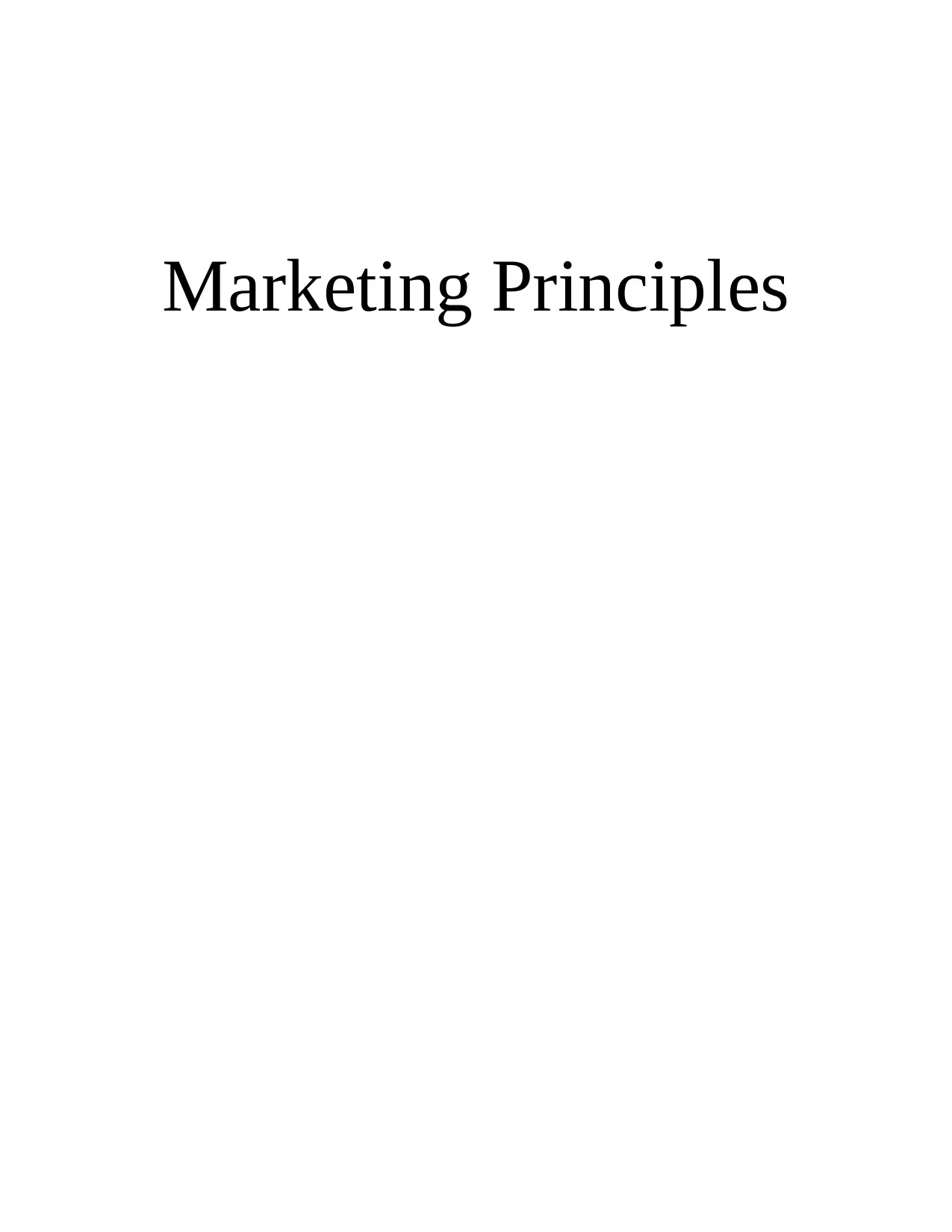
Marketing Principles
Paraphrase This Document
Need a fresh take? Get an instant paraphrase of this document with our AI Paraphraser
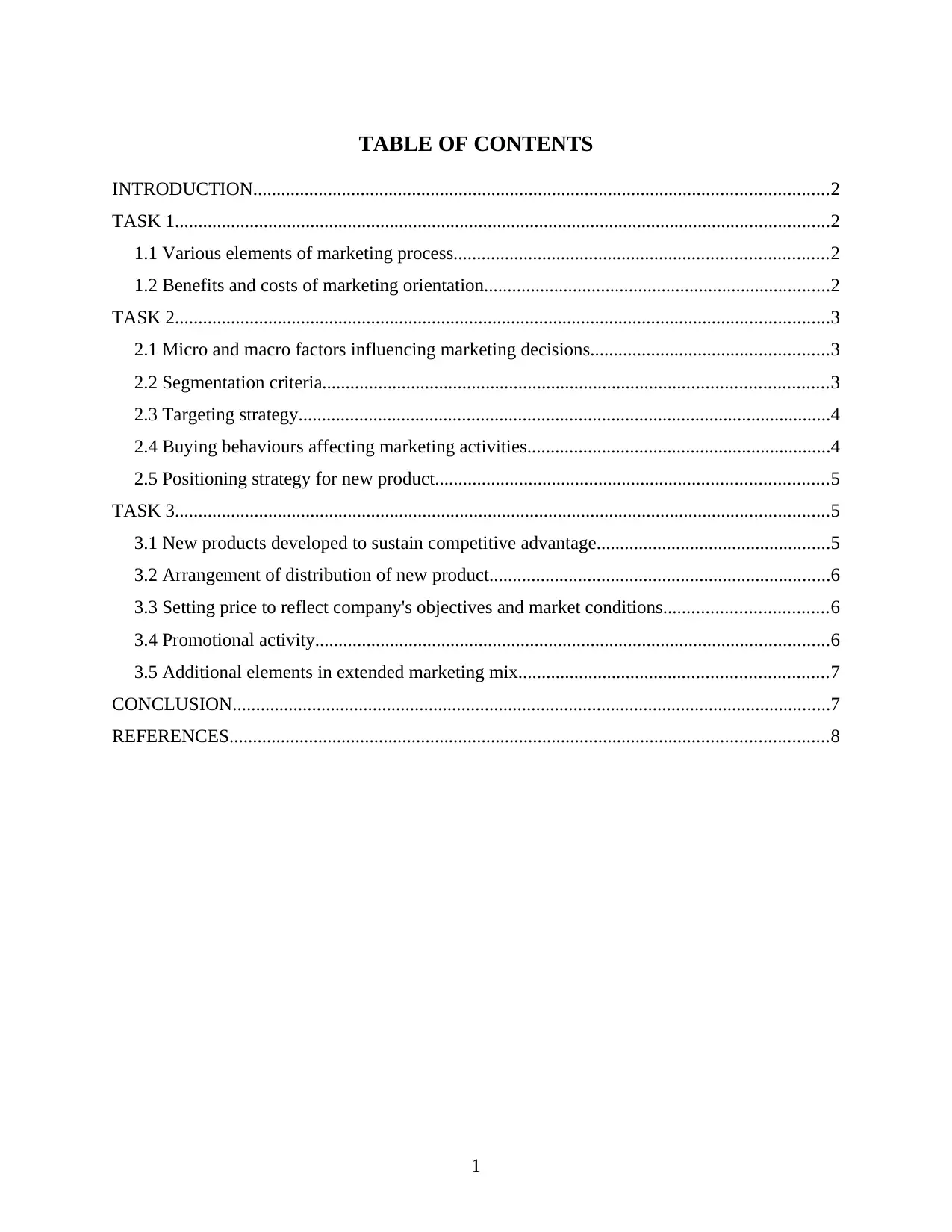
TABLE OF CONTENTS
INTRODUCTION...........................................................................................................................2
TASK 1............................................................................................................................................2
1.1 Various elements of marketing process................................................................................2
1.2 Benefits and costs of marketing orientation..........................................................................2
TASK 2............................................................................................................................................3
2.1 Micro and macro factors influencing marketing decisions...................................................3
2.2 Segmentation criteria............................................................................................................3
2.3 Targeting strategy..................................................................................................................4
2.4 Buying behaviours affecting marketing activities.................................................................4
2.5 Positioning strategy for new product....................................................................................5
TASK 3............................................................................................................................................5
3.1 New products developed to sustain competitive advantage..................................................5
3.2 Arrangement of distribution of new product.........................................................................6
3.3 Setting price to reflect company's objectives and market conditions...................................6
3.4 Promotional activity..............................................................................................................6
3.5 Additional elements in extended marketing mix..................................................................7
CONCLUSION................................................................................................................................7
REFERENCES................................................................................................................................8
1
INTRODUCTION...........................................................................................................................2
TASK 1............................................................................................................................................2
1.1 Various elements of marketing process................................................................................2
1.2 Benefits and costs of marketing orientation..........................................................................2
TASK 2............................................................................................................................................3
2.1 Micro and macro factors influencing marketing decisions...................................................3
2.2 Segmentation criteria............................................................................................................3
2.3 Targeting strategy..................................................................................................................4
2.4 Buying behaviours affecting marketing activities.................................................................4
2.5 Positioning strategy for new product....................................................................................5
TASK 3............................................................................................................................................5
3.1 New products developed to sustain competitive advantage..................................................5
3.2 Arrangement of distribution of new product.........................................................................6
3.3 Setting price to reflect company's objectives and market conditions...................................6
3.4 Promotional activity..............................................................................................................6
3.5 Additional elements in extended marketing mix..................................................................7
CONCLUSION................................................................................................................................7
REFERENCES................................................................................................................................8
1
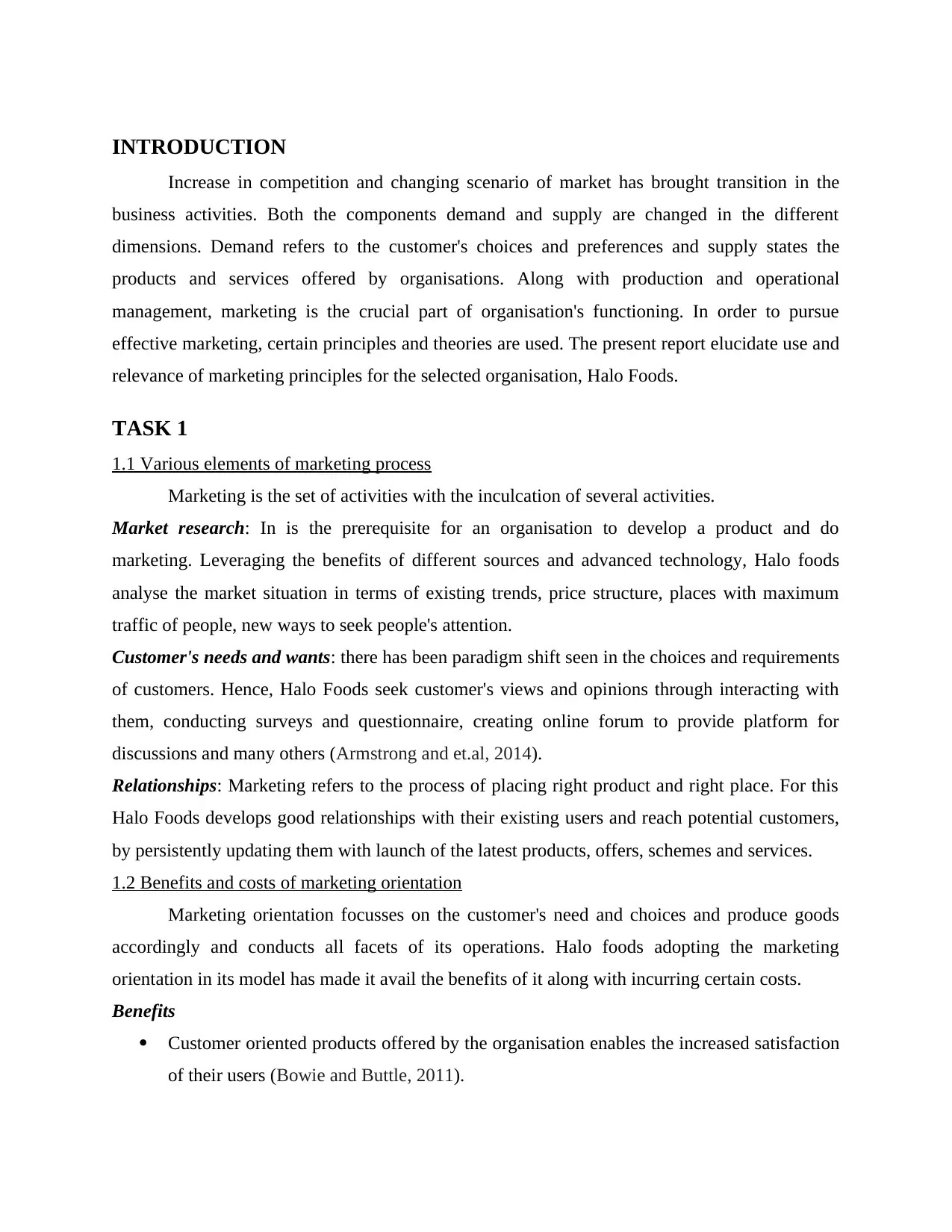
INTRODUCTION
Increase in competition and changing scenario of market has brought transition in the
business activities. Both the components demand and supply are changed in the different
dimensions. Demand refers to the customer's choices and preferences and supply states the
products and services offered by organisations. Along with production and operational
management, marketing is the crucial part of organisation's functioning. In order to pursue
effective marketing, certain principles and theories are used. The present report elucidate use and
relevance of marketing principles for the selected organisation, Halo Foods.
TASK 1
1.1 Various elements of marketing process
Marketing is the set of activities with the inculcation of several activities.
Market research: In is the prerequisite for an organisation to develop a product and do
marketing. Leveraging the benefits of different sources and advanced technology, Halo foods
analyse the market situation in terms of existing trends, price structure, places with maximum
traffic of people, new ways to seek people's attention.
Customer's needs and wants: there has been paradigm shift seen in the choices and requirements
of customers. Hence, Halo Foods seek customer's views and opinions through interacting with
them, conducting surveys and questionnaire, creating online forum to provide platform for
discussions and many others (Armstrong and et.al, 2014).
Relationships: Marketing refers to the process of placing right product and right place. For this
Halo Foods develops good relationships with their existing users and reach potential customers,
by persistently updating them with launch of the latest products, offers, schemes and services.
1.2 Benefits and costs of marketing orientation
Marketing orientation focusses on the customer's need and choices and produce goods
accordingly and conducts all facets of its operations. Halo foods adopting the marketing
orientation in its model has made it avail the benefits of it along with incurring certain costs.
Benefits
Customer oriented products offered by the organisation enables the increased satisfaction
of their users (Bowie and Buttle, 2011).
Increase in competition and changing scenario of market has brought transition in the
business activities. Both the components demand and supply are changed in the different
dimensions. Demand refers to the customer's choices and preferences and supply states the
products and services offered by organisations. Along with production and operational
management, marketing is the crucial part of organisation's functioning. In order to pursue
effective marketing, certain principles and theories are used. The present report elucidate use and
relevance of marketing principles for the selected organisation, Halo Foods.
TASK 1
1.1 Various elements of marketing process
Marketing is the set of activities with the inculcation of several activities.
Market research: In is the prerequisite for an organisation to develop a product and do
marketing. Leveraging the benefits of different sources and advanced technology, Halo foods
analyse the market situation in terms of existing trends, price structure, places with maximum
traffic of people, new ways to seek people's attention.
Customer's needs and wants: there has been paradigm shift seen in the choices and requirements
of customers. Hence, Halo Foods seek customer's views and opinions through interacting with
them, conducting surveys and questionnaire, creating online forum to provide platform for
discussions and many others (Armstrong and et.al, 2014).
Relationships: Marketing refers to the process of placing right product and right place. For this
Halo Foods develops good relationships with their existing users and reach potential customers,
by persistently updating them with launch of the latest products, offers, schemes and services.
1.2 Benefits and costs of marketing orientation
Marketing orientation focusses on the customer's need and choices and produce goods
accordingly and conducts all facets of its operations. Halo foods adopting the marketing
orientation in its model has made it avail the benefits of it along with incurring certain costs.
Benefits
Customer oriented products offered by the organisation enables the increased satisfaction
of their users (Bowie and Buttle, 2011).
⊘ This is a preview!⊘
Do you want full access?
Subscribe today to unlock all pages.

Trusted by 1+ million students worldwide
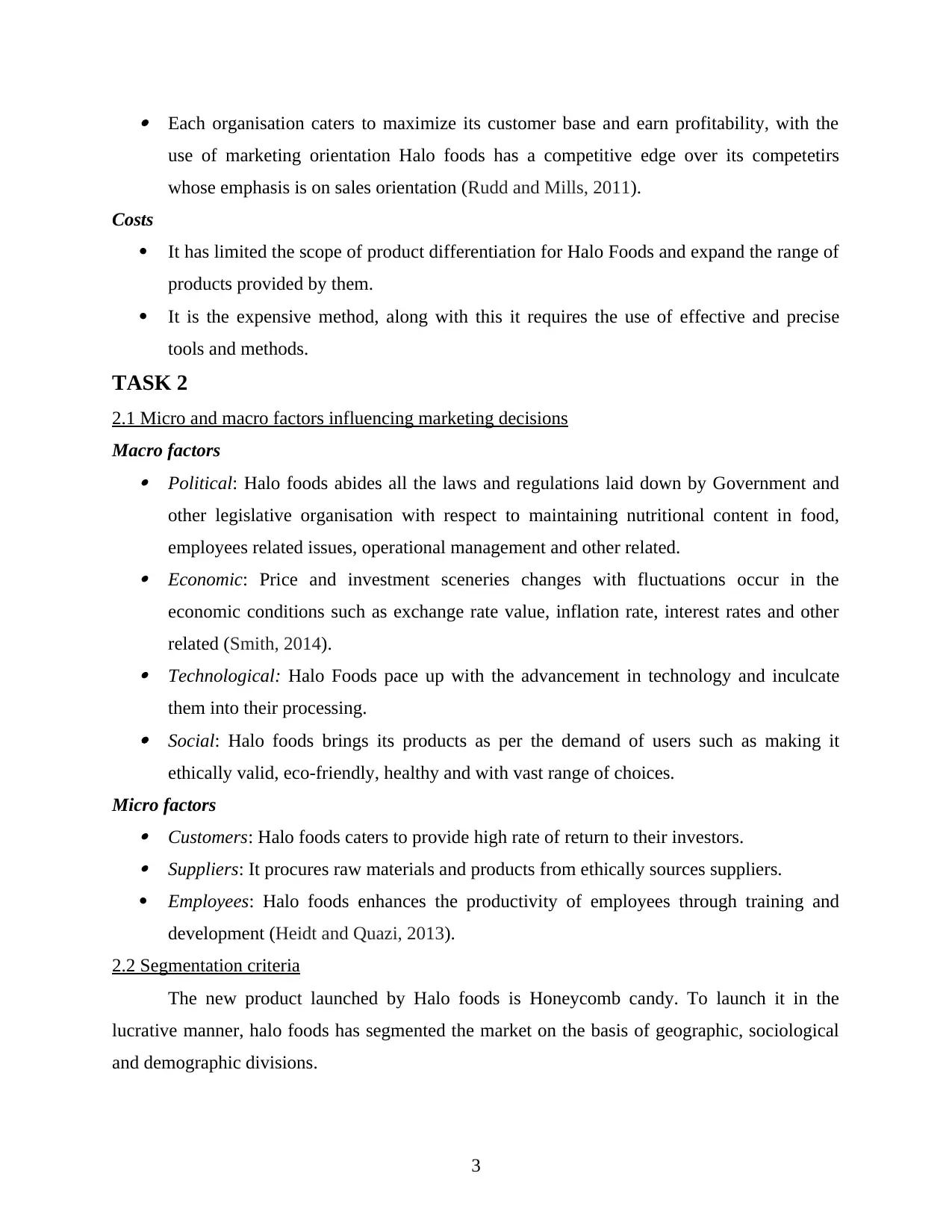
Each organisation caters to maximize its customer base and earn profitability, with the
use of marketing orientation Halo foods has a competitive edge over its competetirs
whose emphasis is on sales orientation (Rudd and Mills, 2011).
Costs
It has limited the scope of product differentiation for Halo Foods and expand the range of
products provided by them.
It is the expensive method, along with this it requires the use of effective and precise
tools and methods.
TASK 2
2.1 Micro and macro factors influencing marketing decisions
Macro factors Political: Halo foods abides all the laws and regulations laid down by Government and
other legislative organisation with respect to maintaining nutritional content in food,
employees related issues, operational management and other related. Economic: Price and investment sceneries changes with fluctuations occur in the
economic conditions such as exchange rate value, inflation rate, interest rates and other
related (Smith, 2014). Technological: Halo Foods pace up with the advancement in technology and inculcate
them into their processing. Social: Halo foods brings its products as per the demand of users such as making it
ethically valid, eco-friendly, healthy and with vast range of choices.
Micro factors Customers: Halo foods caters to provide high rate of return to their investors. Suppliers: It procures raw materials and products from ethically sources suppliers.
Employees: Halo foods enhances the productivity of employees through training and
development (Heidt and Quazi, 2013).
2.2 Segmentation criteria
The new product launched by Halo foods is Honeycomb candy. To launch it in the
lucrative manner, halo foods has segmented the market on the basis of geographic, sociological
and demographic divisions.
3
use of marketing orientation Halo foods has a competitive edge over its competetirs
whose emphasis is on sales orientation (Rudd and Mills, 2011).
Costs
It has limited the scope of product differentiation for Halo Foods and expand the range of
products provided by them.
It is the expensive method, along with this it requires the use of effective and precise
tools and methods.
TASK 2
2.1 Micro and macro factors influencing marketing decisions
Macro factors Political: Halo foods abides all the laws and regulations laid down by Government and
other legislative organisation with respect to maintaining nutritional content in food,
employees related issues, operational management and other related. Economic: Price and investment sceneries changes with fluctuations occur in the
economic conditions such as exchange rate value, inflation rate, interest rates and other
related (Smith, 2014). Technological: Halo Foods pace up with the advancement in technology and inculcate
them into their processing. Social: Halo foods brings its products as per the demand of users such as making it
ethically valid, eco-friendly, healthy and with vast range of choices.
Micro factors Customers: Halo foods caters to provide high rate of return to their investors. Suppliers: It procures raw materials and products from ethically sources suppliers.
Employees: Halo foods enhances the productivity of employees through training and
development (Heidt and Quazi, 2013).
2.2 Segmentation criteria
The new product launched by Halo foods is Honeycomb candy. To launch it in the
lucrative manner, halo foods has segmented the market on the basis of geographic, sociological
and demographic divisions.
3
Paraphrase This Document
Need a fresh take? Get an instant paraphrase of this document with our AI Paraphraser
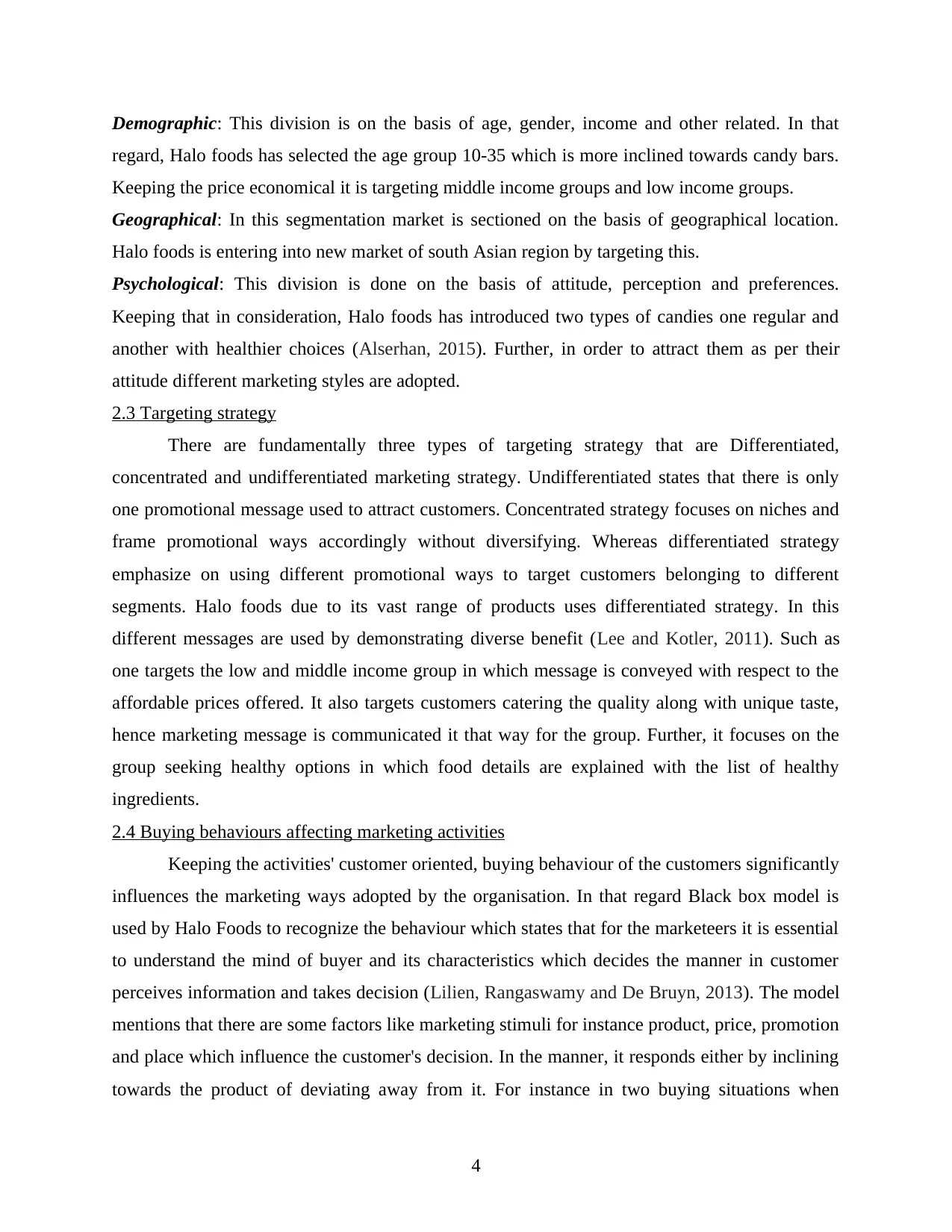
Demographic: This division is on the basis of age, gender, income and other related. In that
regard, Halo foods has selected the age group 10-35 which is more inclined towards candy bars.
Keeping the price economical it is targeting middle income groups and low income groups.
Geographical: In this segmentation market is sectioned on the basis of geographical location.
Halo foods is entering into new market of south Asian region by targeting this.
Psychological: This division is done on the basis of attitude, perception and preferences.
Keeping that in consideration, Halo foods has introduced two types of candies one regular and
another with healthier choices (Alserhan, 2015). Further, in order to attract them as per their
attitude different marketing styles are adopted.
2.3 Targeting strategy
There are fundamentally three types of targeting strategy that are Differentiated,
concentrated and undifferentiated marketing strategy. Undifferentiated states that there is only
one promotional message used to attract customers. Concentrated strategy focuses on niches and
frame promotional ways accordingly without diversifying. Whereas differentiated strategy
emphasize on using different promotional ways to target customers belonging to different
segments. Halo foods due to its vast range of products uses differentiated strategy. In this
different messages are used by demonstrating diverse benefit (Lee and Kotler, 2011). Such as
one targets the low and middle income group in which message is conveyed with respect to the
affordable prices offered. It also targets customers catering the quality along with unique taste,
hence marketing message is communicated it that way for the group. Further, it focuses on the
group seeking healthy options in which food details are explained with the list of healthy
ingredients.
2.4 Buying behaviours affecting marketing activities
Keeping the activities' customer oriented, buying behaviour of the customers significantly
influences the marketing ways adopted by the organisation. In that regard Black box model is
used by Halo Foods to recognize the behaviour which states that for the marketeers it is essential
to understand the mind of buyer and its characteristics which decides the manner in customer
perceives information and takes decision (Lilien, Rangaswamy and De Bruyn, 2013). The model
mentions that there are some factors like marketing stimuli for instance product, price, promotion
and place which influence the customer's decision. In the manner, it responds either by inclining
towards the product of deviating away from it. For instance in two buying situations when
4
regard, Halo foods has selected the age group 10-35 which is more inclined towards candy bars.
Keeping the price economical it is targeting middle income groups and low income groups.
Geographical: In this segmentation market is sectioned on the basis of geographical location.
Halo foods is entering into new market of south Asian region by targeting this.
Psychological: This division is done on the basis of attitude, perception and preferences.
Keeping that in consideration, Halo foods has introduced two types of candies one regular and
another with healthier choices (Alserhan, 2015). Further, in order to attract them as per their
attitude different marketing styles are adopted.
2.3 Targeting strategy
There are fundamentally three types of targeting strategy that are Differentiated,
concentrated and undifferentiated marketing strategy. Undifferentiated states that there is only
one promotional message used to attract customers. Concentrated strategy focuses on niches and
frame promotional ways accordingly without diversifying. Whereas differentiated strategy
emphasize on using different promotional ways to target customers belonging to different
segments. Halo foods due to its vast range of products uses differentiated strategy. In this
different messages are used by demonstrating diverse benefit (Lee and Kotler, 2011). Such as
one targets the low and middle income group in which message is conveyed with respect to the
affordable prices offered. It also targets customers catering the quality along with unique taste,
hence marketing message is communicated it that way for the group. Further, it focuses on the
group seeking healthy options in which food details are explained with the list of healthy
ingredients.
2.4 Buying behaviours affecting marketing activities
Keeping the activities' customer oriented, buying behaviour of the customers significantly
influences the marketing ways adopted by the organisation. In that regard Black box model is
used by Halo Foods to recognize the behaviour which states that for the marketeers it is essential
to understand the mind of buyer and its characteristics which decides the manner in customer
perceives information and takes decision (Lilien, Rangaswamy and De Bruyn, 2013). The model
mentions that there are some factors like marketing stimuli for instance product, price, promotion
and place which influence the customer's decision. In the manner, it responds either by inclining
towards the product of deviating away from it. For instance in two buying situations when
4
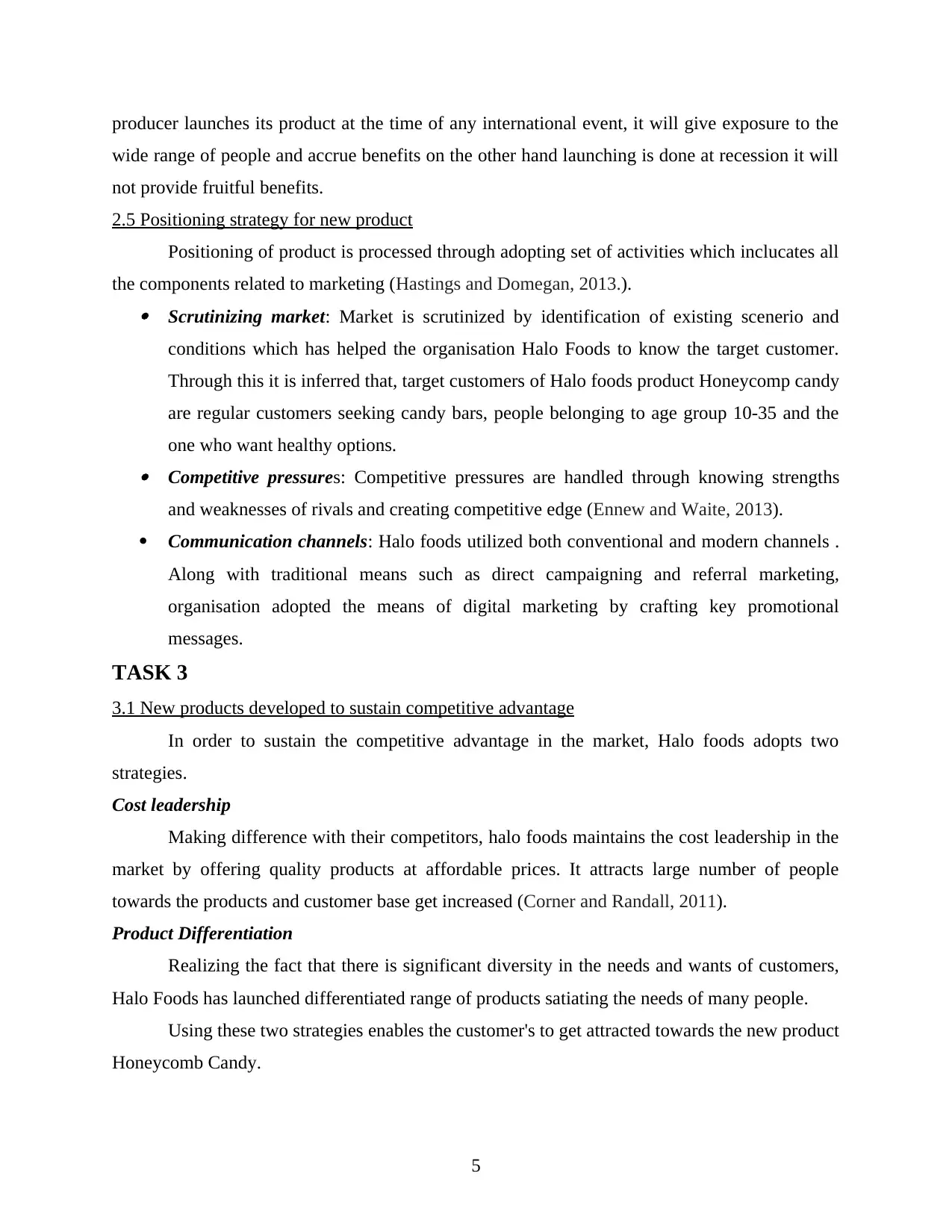
producer launches its product at the time of any international event, it will give exposure to the
wide range of people and accrue benefits on the other hand launching is done at recession it will
not provide fruitful benefits.
2.5 Positioning strategy for new product
Positioning of product is processed through adopting set of activities which inclucates all
the components related to marketing (Hastings and Domegan, 2013.). Scrutinizing market: Market is scrutinized by identification of existing scenerio and
conditions which has helped the organisation Halo Foods to know the target customer.
Through this it is inferred that, target customers of Halo foods product Honeycomp candy
are regular customers seeking candy bars, people belonging to age group 10-35 and the
one who want healthy options. Competitive pressures: Competitive pressures are handled through knowing strengths
and weaknesses of rivals and creating competitive edge (Ennew and Waite, 2013).
Communication channels: Halo foods utilized both conventional and modern channels .
Along with traditional means such as direct campaigning and referral marketing,
organisation adopted the means of digital marketing by crafting key promotional
messages.
TASK 3
3.1 New products developed to sustain competitive advantage
In order to sustain the competitive advantage in the market, Halo foods adopts two
strategies.
Cost leadership
Making difference with their competitors, halo foods maintains the cost leadership in the
market by offering quality products at affordable prices. It attracts large number of people
towards the products and customer base get increased (Corner and Randall, 2011).
Product Differentiation
Realizing the fact that there is significant diversity in the needs and wants of customers,
Halo Foods has launched differentiated range of products satiating the needs of many people.
Using these two strategies enables the customer's to get attracted towards the new product
Honeycomb Candy.
5
wide range of people and accrue benefits on the other hand launching is done at recession it will
not provide fruitful benefits.
2.5 Positioning strategy for new product
Positioning of product is processed through adopting set of activities which inclucates all
the components related to marketing (Hastings and Domegan, 2013.). Scrutinizing market: Market is scrutinized by identification of existing scenerio and
conditions which has helped the organisation Halo Foods to know the target customer.
Through this it is inferred that, target customers of Halo foods product Honeycomp candy
are regular customers seeking candy bars, people belonging to age group 10-35 and the
one who want healthy options. Competitive pressures: Competitive pressures are handled through knowing strengths
and weaknesses of rivals and creating competitive edge (Ennew and Waite, 2013).
Communication channels: Halo foods utilized both conventional and modern channels .
Along with traditional means such as direct campaigning and referral marketing,
organisation adopted the means of digital marketing by crafting key promotional
messages.
TASK 3
3.1 New products developed to sustain competitive advantage
In order to sustain the competitive advantage in the market, Halo foods adopts two
strategies.
Cost leadership
Making difference with their competitors, halo foods maintains the cost leadership in the
market by offering quality products at affordable prices. It attracts large number of people
towards the products and customer base get increased (Corner and Randall, 2011).
Product Differentiation
Realizing the fact that there is significant diversity in the needs and wants of customers,
Halo Foods has launched differentiated range of products satiating the needs of many people.
Using these two strategies enables the customer's to get attracted towards the new product
Honeycomb Candy.
5
⊘ This is a preview!⊘
Do you want full access?
Subscribe today to unlock all pages.

Trusted by 1+ million students worldwide
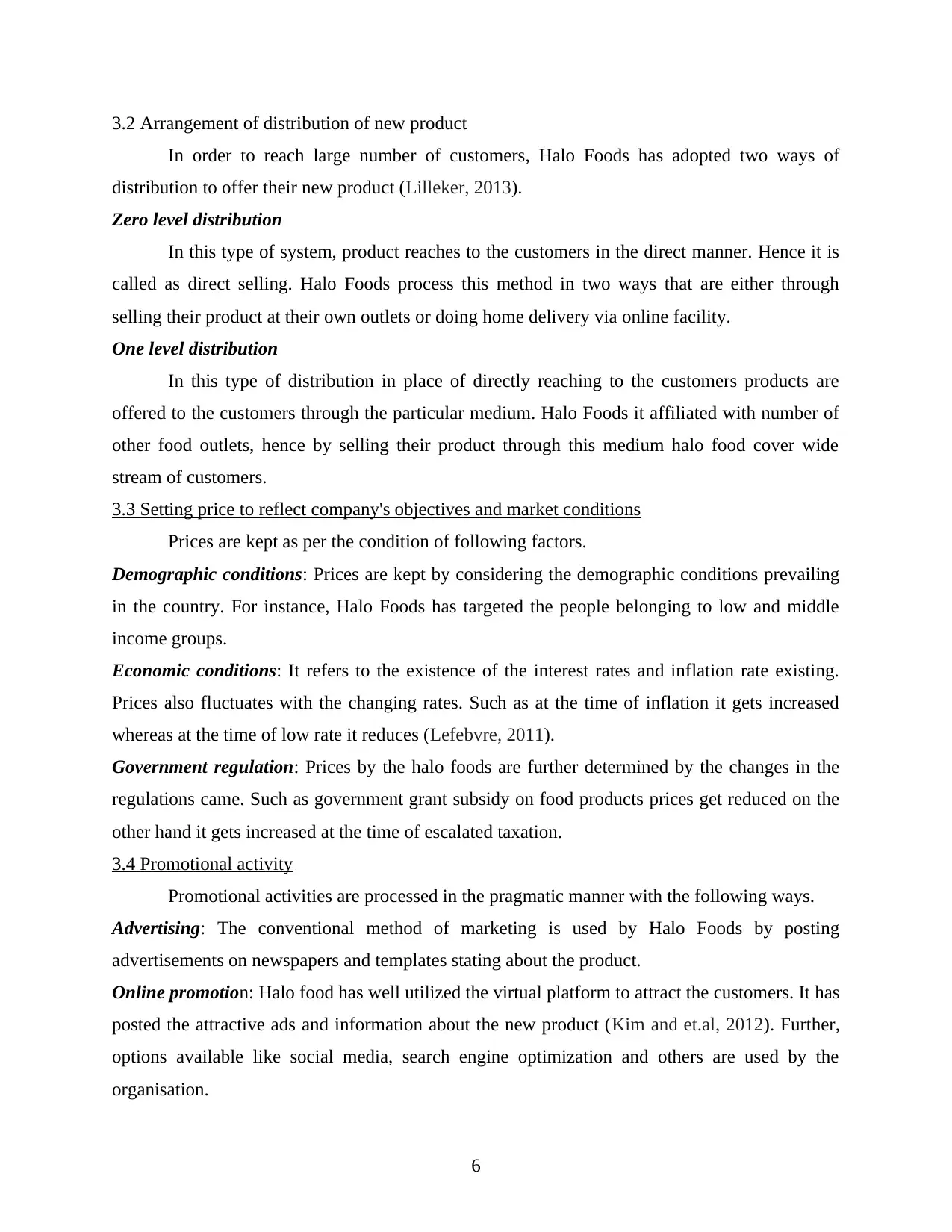
3.2 Arrangement of distribution of new product
In order to reach large number of customers, Halo Foods has adopted two ways of
distribution to offer their new product (Lilleker, 2013).
Zero level distribution
In this type of system, product reaches to the customers in the direct manner. Hence it is
called as direct selling. Halo Foods process this method in two ways that are either through
selling their product at their own outlets or doing home delivery via online facility.
One level distribution
In this type of distribution in place of directly reaching to the customers products are
offered to the customers through the particular medium. Halo Foods it affiliated with number of
other food outlets, hence by selling their product through this medium halo food cover wide
stream of customers.
3.3 Setting price to reflect company's objectives and market conditions
Prices are kept as per the condition of following factors.
Demographic conditions: Prices are kept by considering the demographic conditions prevailing
in the country. For instance, Halo Foods has targeted the people belonging to low and middle
income groups.
Economic conditions: It refers to the existence of the interest rates and inflation rate existing.
Prices also fluctuates with the changing rates. Such as at the time of inflation it gets increased
whereas at the time of low rate it reduces (Lefebvre, 2011).
Government regulation: Prices by the halo foods are further determined by the changes in the
regulations came. Such as government grant subsidy on food products prices get reduced on the
other hand it gets increased at the time of escalated taxation.
3.4 Promotional activity
Promotional activities are processed in the pragmatic manner with the following ways.
Advertising: The conventional method of marketing is used by Halo Foods by posting
advertisements on newspapers and templates stating about the product.
Online promotion: Halo food has well utilized the virtual platform to attract the customers. It has
posted the attractive ads and information about the new product (Kim and et.al, 2012). Further,
options available like social media, search engine optimization and others are used by the
organisation.
6
In order to reach large number of customers, Halo Foods has adopted two ways of
distribution to offer their new product (Lilleker, 2013).
Zero level distribution
In this type of system, product reaches to the customers in the direct manner. Hence it is
called as direct selling. Halo Foods process this method in two ways that are either through
selling their product at their own outlets or doing home delivery via online facility.
One level distribution
In this type of distribution in place of directly reaching to the customers products are
offered to the customers through the particular medium. Halo Foods it affiliated with number of
other food outlets, hence by selling their product through this medium halo food cover wide
stream of customers.
3.3 Setting price to reflect company's objectives and market conditions
Prices are kept as per the condition of following factors.
Demographic conditions: Prices are kept by considering the demographic conditions prevailing
in the country. For instance, Halo Foods has targeted the people belonging to low and middle
income groups.
Economic conditions: It refers to the existence of the interest rates and inflation rate existing.
Prices also fluctuates with the changing rates. Such as at the time of inflation it gets increased
whereas at the time of low rate it reduces (Lefebvre, 2011).
Government regulation: Prices by the halo foods are further determined by the changes in the
regulations came. Such as government grant subsidy on food products prices get reduced on the
other hand it gets increased at the time of escalated taxation.
3.4 Promotional activity
Promotional activities are processed in the pragmatic manner with the following ways.
Advertising: The conventional method of marketing is used by Halo Foods by posting
advertisements on newspapers and templates stating about the product.
Online promotion: Halo food has well utilized the virtual platform to attract the customers. It has
posted the attractive ads and information about the new product (Kim and et.al, 2012). Further,
options available like social media, search engine optimization and others are used by the
organisation.
6
Paraphrase This Document
Need a fresh take? Get an instant paraphrase of this document with our AI Paraphraser
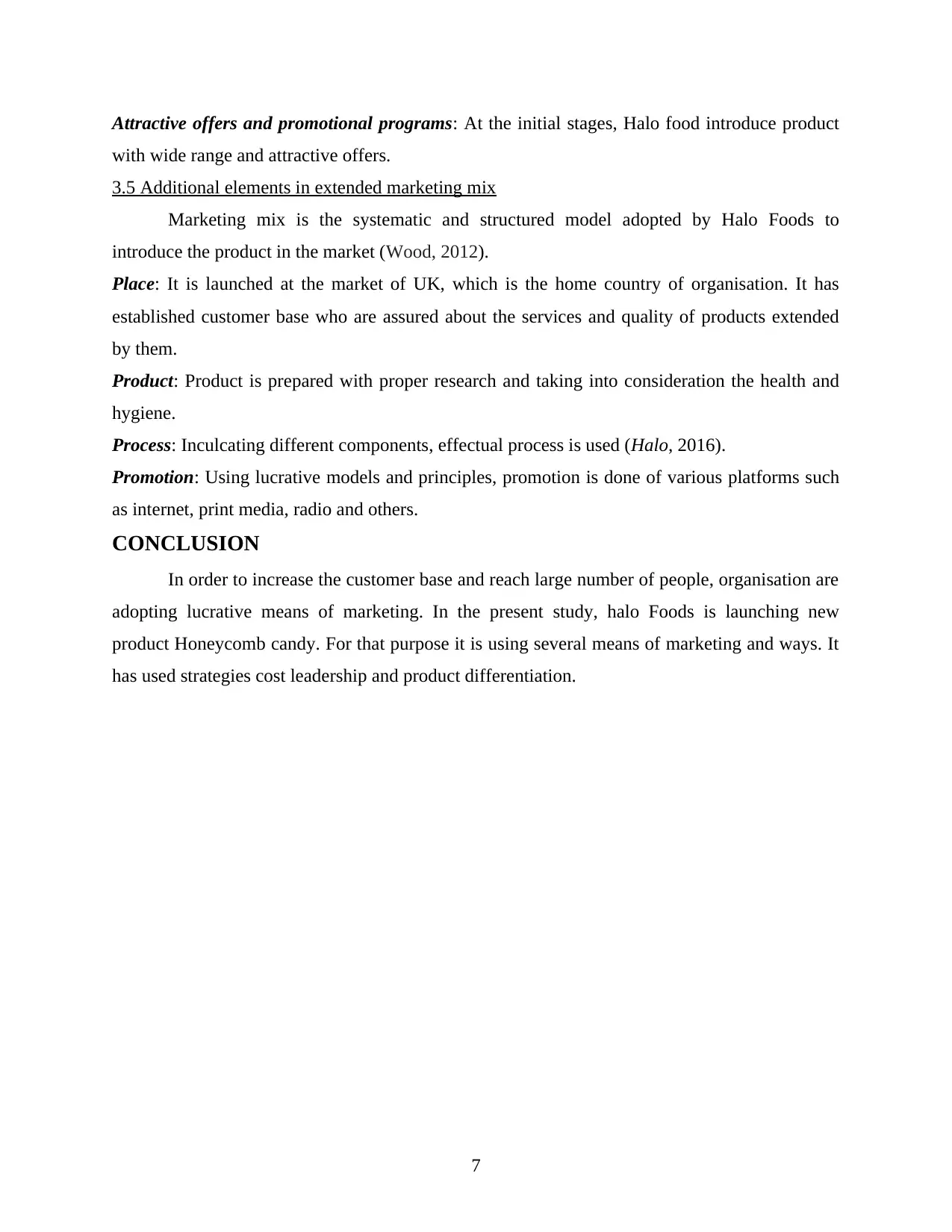
Attractive offers and promotional programs: At the initial stages, Halo food introduce product
with wide range and attractive offers.
3.5 Additional elements in extended marketing mix
Marketing mix is the systematic and structured model adopted by Halo Foods to
introduce the product in the market (Wood, 2012).
Place: It is launched at the market of UK, which is the home country of organisation. It has
established customer base who are assured about the services and quality of products extended
by them.
Product: Product is prepared with proper research and taking into consideration the health and
hygiene.
Process: Inculcating different components, effectual process is used (Halo, 2016).
Promotion: Using lucrative models and principles, promotion is done of various platforms such
as internet, print media, radio and others.
CONCLUSION
In order to increase the customer base and reach large number of people, organisation are
adopting lucrative means of marketing. In the present study, halo Foods is launching new
product Honeycomb candy. For that purpose it is using several means of marketing and ways. It
has used strategies cost leadership and product differentiation.
7
with wide range and attractive offers.
3.5 Additional elements in extended marketing mix
Marketing mix is the systematic and structured model adopted by Halo Foods to
introduce the product in the market (Wood, 2012).
Place: It is launched at the market of UK, which is the home country of organisation. It has
established customer base who are assured about the services and quality of products extended
by them.
Product: Product is prepared with proper research and taking into consideration the health and
hygiene.
Process: Inculcating different components, effectual process is used (Halo, 2016).
Promotion: Using lucrative models and principles, promotion is done of various platforms such
as internet, print media, radio and others.
CONCLUSION
In order to increase the customer base and reach large number of people, organisation are
adopting lucrative means of marketing. In the present study, halo Foods is launching new
product Honeycomb candy. For that purpose it is using several means of marketing and ways. It
has used strategies cost leadership and product differentiation.
7
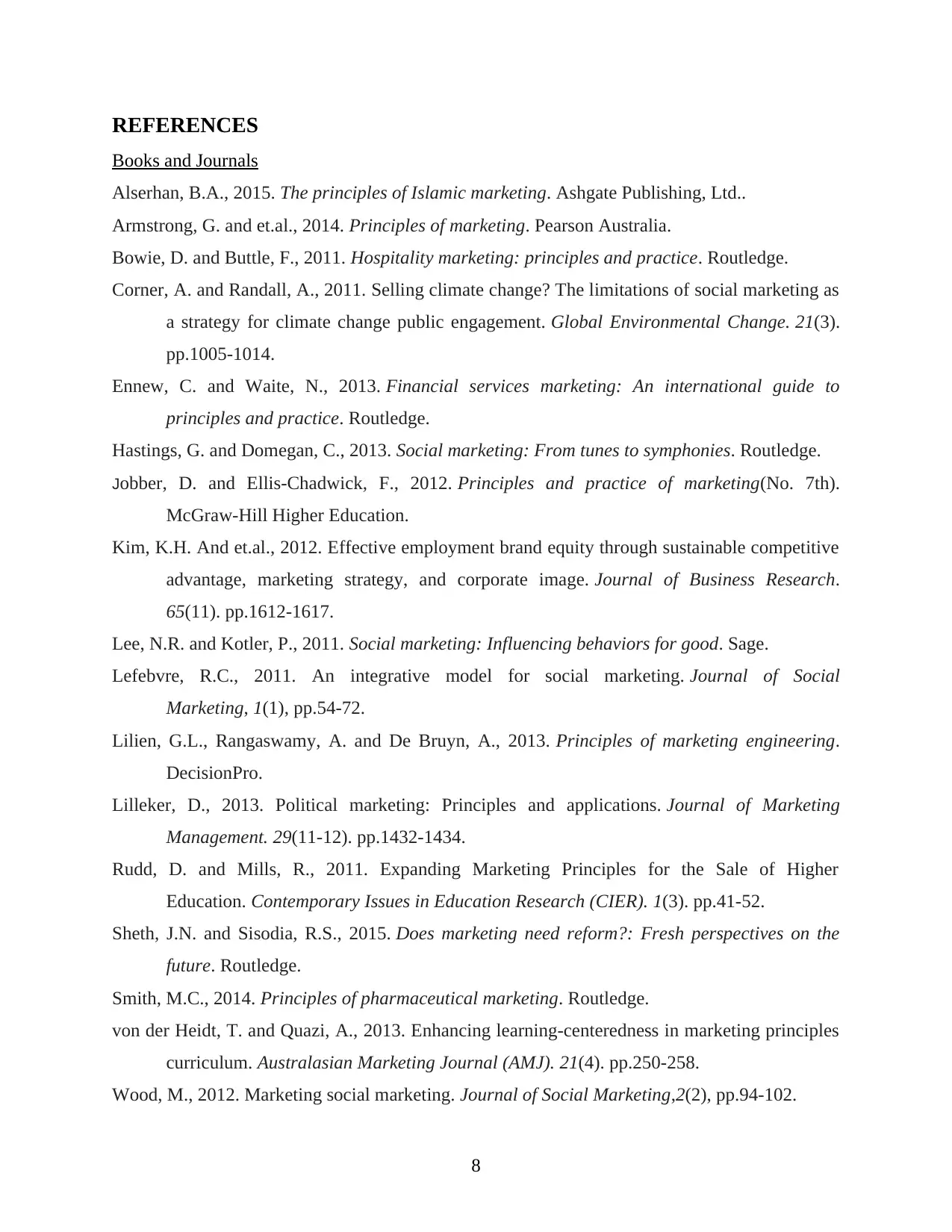
REFERENCES
Books and Journals
Alserhan, B.A., 2015. The principles of Islamic marketing. Ashgate Publishing, Ltd..
Armstrong, G. and et.al., 2014. Principles of marketing. Pearson Australia.
Bowie, D. and Buttle, F., 2011. Hospitality marketing: principles and practice. Routledge.
Corner, A. and Randall, A., 2011. Selling climate change? The limitations of social marketing as
a strategy for climate change public engagement. Global Environmental Change. 21(3).
pp.1005-1014.
Ennew, C. and Waite, N., 2013. Financial services marketing: An international guide to
principles and practice. Routledge.
Hastings, G. and Domegan, C., 2013. Social marketing: From tunes to symphonies. Routledge.
Jobber, D. and Ellis-Chadwick, F., 2012. Principles and practice of marketing(No. 7th).
McGraw-Hill Higher Education.
Kim, K.H. And et.al., 2012. Effective employment brand equity through sustainable competitive
advantage, marketing strategy, and corporate image. Journal of Business Research.
65(11). pp.1612-1617.
Lee, N.R. and Kotler, P., 2011. Social marketing: Influencing behaviors for good. Sage.
Lefebvre, R.C., 2011. An integrative model for social marketing. Journal of Social
Marketing, 1(1), pp.54-72.
Lilien, G.L., Rangaswamy, A. and De Bruyn, A., 2013. Principles of marketing engineering.
DecisionPro.
Lilleker, D., 2013. Political marketing: Principles and applications. Journal of Marketing
Management. 29(11-12). pp.1432-1434.
Rudd, D. and Mills, R., 2011. Expanding Marketing Principles for the Sale of Higher
Education. Contemporary Issues in Education Research (CIER). 1(3). pp.41-52.
Sheth, J.N. and Sisodia, R.S., 2015. Does marketing need reform?: Fresh perspectives on the
future. Routledge.
Smith, M.C., 2014. Principles of pharmaceutical marketing. Routledge.
von der Heidt, T. and Quazi, A., 2013. Enhancing learning-centeredness in marketing principles
curriculum. Australasian Marketing Journal (AMJ). 21(4). pp.250-258.
Wood, M., 2012. Marketing social marketing. Journal of Social Marketing,2(2), pp.94-102.
8
Books and Journals
Alserhan, B.A., 2015. The principles of Islamic marketing. Ashgate Publishing, Ltd..
Armstrong, G. and et.al., 2014. Principles of marketing. Pearson Australia.
Bowie, D. and Buttle, F., 2011. Hospitality marketing: principles and practice. Routledge.
Corner, A. and Randall, A., 2011. Selling climate change? The limitations of social marketing as
a strategy for climate change public engagement. Global Environmental Change. 21(3).
pp.1005-1014.
Ennew, C. and Waite, N., 2013. Financial services marketing: An international guide to
principles and practice. Routledge.
Hastings, G. and Domegan, C., 2013. Social marketing: From tunes to symphonies. Routledge.
Jobber, D. and Ellis-Chadwick, F., 2012. Principles and practice of marketing(No. 7th).
McGraw-Hill Higher Education.
Kim, K.H. And et.al., 2012. Effective employment brand equity through sustainable competitive
advantage, marketing strategy, and corporate image. Journal of Business Research.
65(11). pp.1612-1617.
Lee, N.R. and Kotler, P., 2011. Social marketing: Influencing behaviors for good. Sage.
Lefebvre, R.C., 2011. An integrative model for social marketing. Journal of Social
Marketing, 1(1), pp.54-72.
Lilien, G.L., Rangaswamy, A. and De Bruyn, A., 2013. Principles of marketing engineering.
DecisionPro.
Lilleker, D., 2013. Political marketing: Principles and applications. Journal of Marketing
Management. 29(11-12). pp.1432-1434.
Rudd, D. and Mills, R., 2011. Expanding Marketing Principles for the Sale of Higher
Education. Contemporary Issues in Education Research (CIER). 1(3). pp.41-52.
Sheth, J.N. and Sisodia, R.S., 2015. Does marketing need reform?: Fresh perspectives on the
future. Routledge.
Smith, M.C., 2014. Principles of pharmaceutical marketing. Routledge.
von der Heidt, T. and Quazi, A., 2013. Enhancing learning-centeredness in marketing principles
curriculum. Australasian Marketing Journal (AMJ). 21(4). pp.250-258.
Wood, M., 2012. Marketing social marketing. Journal of Social Marketing,2(2), pp.94-102.
8
⊘ This is a preview!⊘
Do you want full access?
Subscribe today to unlock all pages.

Trusted by 1+ million students worldwide

Online
Halo. 2016. [Online]. Available through:<http://www.halofoods.co.uk/about.htm>. [Accessed
on 5th March 2016].
9
Halo. 2016. [Online]. Available through:<http://www.halofoods.co.uk/about.htm>. [Accessed
on 5th March 2016].
9
1 out of 10
Related Documents
Your All-in-One AI-Powered Toolkit for Academic Success.
+13062052269
info@desklib.com
Available 24*7 on WhatsApp / Email
![[object Object]](/_next/static/media/star-bottom.7253800d.svg)
Unlock your academic potential
Copyright © 2020–2025 A2Z Services. All Rights Reserved. Developed and managed by ZUCOL.





